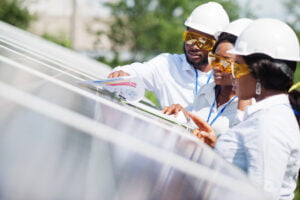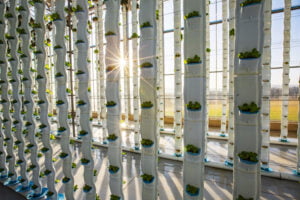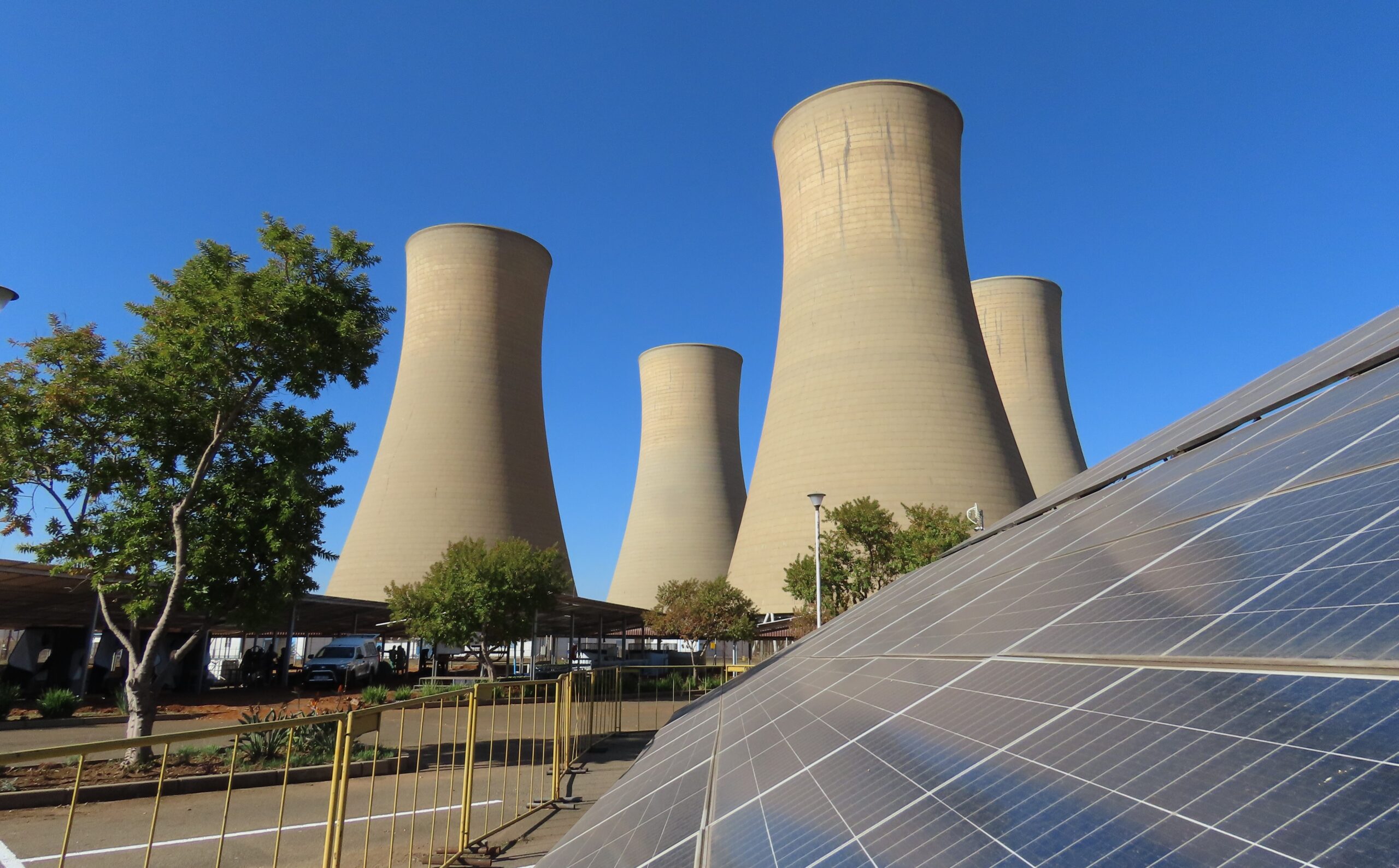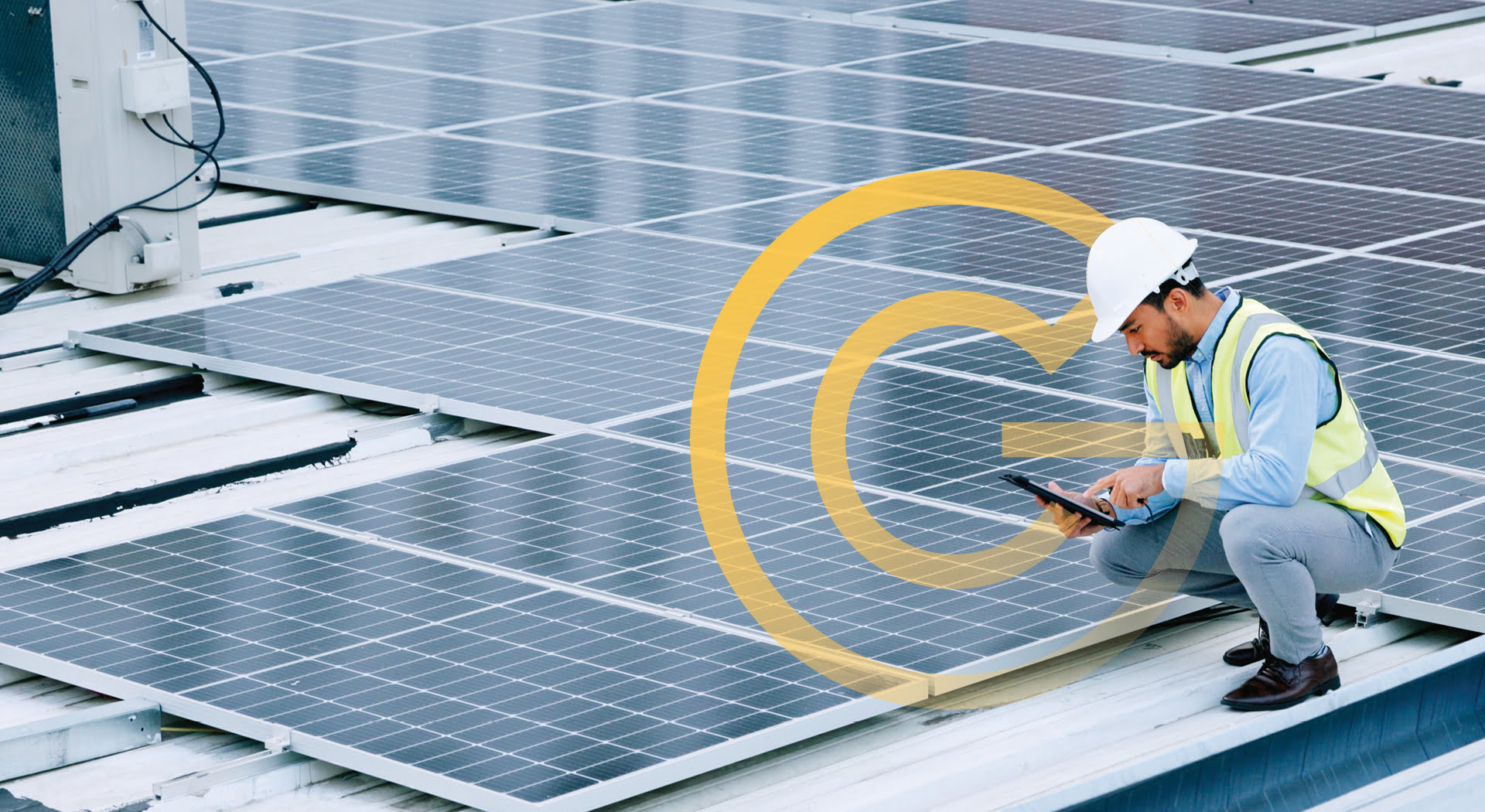The building blocks of any economy are the same: To power an economy, we need sources of energy. To grow our community, we must provide food and other resources. We need infrastructure to supply and distribute water and sanitation services. We require a waste management system which can capture, process and safely dispose of, or clean, the waste we generate. And for all of the above, we require modes of transportation.
However, not all economies are built the same. For far too long people have pursued a form of economy, a linear “take-make-waste” model based on the extraction and consumption of limited fossil fuel resources. This has gradually plunged us into a number of crises including the global climate crisis, the 6th extinction, resource availability crises, landfill airspace shortages and significant widespread inequality. Globally, there is now an urgent trend towards transitioning to alternative ways of operating.
A green economy has all of the same building blocks of its linear counterpart, but with an emphasis on technological solutions that are circular, clean, renewable, sustainable and, critically, also profitable. Moreover, a green economy is one that is considered socially inclusive, creating meaningful and dignified job opportunities and focused on service delivery to those communities that are most vulnerable. For businesses which transition to green technologies, enhanced business resilience and profitability are anticipated outcomes.
Through its partnership with the City of Cape Town, GreenCape – a non-profit organisation which drives the widespread adoption of economically viable greentech solutions across Africa – has published a suite of freely available case studies and industry briefs designed to showcase the broad range of green economy opportunities, solutions and interventions, across all of the aforementioned sectors, which are currently present within Cape Town. The examples provided below are not exhaustive, but paint a clear picture of the type of opportunities that exist within Cape Town’s enabling environment.

The Energy Crisis
For South Africans, the most glaringly obvious challenge facing our country is our energy crisis. Loadshedding is now a daily reality, with the schedule so extreme we shift through many stages a day. Indeed, in 2023 we’ve seen more hours of loadshedding, and at higher stages, than in any previous year, and we still have months to go!
For businesses, the combination of energy insecurity and rising Eskom tariffs makes the provision of electricity a major liability. There is now a huge movement for businesses to ensure security of supply, with many opting for the costly and dirty solution of running diesel generators, or seeking energy storage solutions. But those are not the only solutions. There is an increasingly strong business case for small-scale embedded generation (SSEG) – a green economy solution which allows for the generation of clean, renewable energy, at a cost significantly lower than that of Eskom tariffs.
Indeed, the uptake of SSEG has exploded in South Africa, particularly in the commercial and industrial (C&I) sectors.

So, what’s the catch?
Until recently, a significant one was the upfront capital costs associated with installing a solar photovoltaic (PV) system. But accessing finance has now shifted from being a barrier to becoming a competitive means of extracting additional value.
Consequently, the most significant consideration for companies is selecting the most appropriate financing option for their project and a range of innovative financing options exist. Whilst outright purchases still provide the best return on investment over the lifetime of the asset, power purchase agreements (PPAs) and lease agreements have cash flow and system performance benefits, and provide great alternatives for businesses without the upfront capital for a solar PV system.
Many businesses are starting to take up these opportunities. For example, Pick n Pay (Brackenfell, Cape Town) has demonstrated the benefits experienced from installing a 250.8 kW solar PV system (developed, designed and installed by Emergent Energy and financed through a solar rooftop rental agreement by Decentral Energy).
Urban agriculture – the growth of cannabis
Turning to agriculture, a trio of urban agricultural opportunities in the hemp market – in pharmaceuticals, in the construction industry and in textiles production – demonstrate the inherent potential within Cape Town’s urban agricultural market.
Globally, the cannabis sector is growing, and is currently valued at ~$51.28 billion (Statistica 2023). Nationally, recent policy and regulatory changes have created an enabling environment that is opening up local opportunities for investment and job creation within the cannabis sector.
In Cape Town, the first of these key opportunities for investment in the cannabis sector, lies within the pharmaceuticals industry.
Because medicinal cannabis can be grown in three different production systems (indoor, greenhouse or outdoor), opportunities exist across the value chain, not only in cultivation and processing, but also in the companies that provide the required agro-technologies and services.
The medicinal cannabis companies in the Western Cape use both greenhouse and indoor production systems and so agro-technology suppliers of systems such as lighting, fertigation (the practice of applying fertilizer solutions with irrigation water), drip irrigation, and water treatment etc., will benefit from the greater market demand as more medicinal cannabis start-ups set up facilities. Industrial zones, such as Epping, are well-suited for start-ups looking to repurpose existing warehouses and set up indoor facilities.
Additionally, in 2018, Cape Town was the leading medical destination for medical travellers in Africa and has a competitive advantage in that it has world renowned doctors, a medical industry which has pioneered many ground-breaking surgeries, and a favourable currency exchange rate (in comparison to the US Dollar, Pound Sterling and Euro). This only serves to highlight the potential of the opportunity within the Cape Town context.
In addition to pharmaceuticals, there is a growing global interest in the use of hemp in the construction sector, particularly as the sector looks at different pathways for reducing the overall carbon footprint of the value chain. It is estimated that the building and construction sector accounts for around 40% of greenhouse gas (GHG) emissions globally, from materials to heating, cooling, and lighting (Muller et al 2020). There is also growing concern that the price of building material inputs will continue to increase at a rate greater than building prices, making construction profit margins tighter.
The most popular hemp construction materials are hempcrete and hemp insulation, particularly because the properties of hemp, such as its mould- and mildew resistance, breathability, fire-resistance and tensile strength make it a good insulation material.
Hempcrete is a bio-composite material, made from hemp hurd (the coarse parts of hemp that adhere to the fibre after it is separated), lime binder and water. The mixture can be produced as a slurry to form a solid wall or poured into moulds to form bricks (Hempt 2009). The process of manufacturing hempcrete produces less carbon than is absorbed in the biomass of the hemp plant, making it a vehicle for carbon storage. It is estimated that hempcrete can sequester 108kg of carbon dioxide per cubic metre, acting as a carbon sink for the lifespan of the building (Envirotecture 2012).
A positive indication of this local interest in the use of hemp in construction has been the recent completion of the “Hemp Hotel” in Cape Town. The building has 54 rooms and stands at 12 storeys and is the “tallest building to incorporate hemp-based materials in the world”, according to the director of the International Hemp Building Association.
Finally, Hemp can also be used as a substitute raw material in textiles, replacing less sustainable plant fibres such as cotton. There are opportunities to invest in the primary production of hemp, which generates more revenue per hectare than other plant fibres, and can be sold to local or international markets. There are also opportunities to invest in the mid-stream processing and spinning capacity of hemp textiles.
Cape Town, as one of two traditional clothing and textile hubs of South Africa (the other being eThekwini, KwaZulu-Natal), is well-positioned to become a hemp textile processing hub. It is already home to a number of hemp apparel businesses and most head offices of major national clothing retailers, enabling a vertically-integrated value chain.

Cape Town has historically been a strong region for South Africa’s clothing manufacturing industry hosting 175 (82%) of the 214 clothing manufacturers in the Western Cape. Cape Town also hosts the majority of South Africa’s largest domestic clothing retailers and is well known for its fashion and design.
This positioning also lends itself towards another natural transition for the city – threading the loop towards a circular economy for textiles and fibres.
Progress towards a circular economy
A circular economy keeps products, components, and materials at their highest use and / or value for as long as possible. Circularity is also a strong enabler of localising supply chains by cycling secondary products, components, and materials close to the market.
A solution to unlock an agile circular textile supply chain is the recycling of textile waste. Either through down-cycling into lower value products or by recycling back into fibres. Cape Town possesses a number of existing and potential aggregators ready for scaling and upgrading. The potential is, well, palpable.
Creating a circular economy in South Africa and within Cape Town isn’t just the in vogue thing to do – it’s an urgent societal and environmental imperative, and a strategic business decision to remain relevant and competitive in an ever evolving industry.
Since most of South Africa’s municipalities have run out of, or are running out of, landfill airspace, two recent developments, in organics and waste foundry sand (WFS) demonstrate just the latest opportunities for diverting waste from landfill.
Almost a third (31%) of annual global edible food production is lost or wasted: 14% takes place at farm and post-harvest, whilst 17% takes place from distribution to consumer. South Africa fairs worse with ~45% of the ~22.8 million tonnes of edible food never eaten. Our food system is therefore confronted with two incentives/challenges; the need to minimise the ecological footprint of food production whilst maximising food security.
Enter Hermetia illucens, the Black Soldier Fly (BSF); another solution for unlocking the circular economy in Cape Town and to ensure the Western Cape’s 2027 organic waste landfill ban is achieved.

Cape Town is regarded as the epicentre of South Africa’s BSF industry, and a global hub for innovators. In 2015, Cape Town made global headlines when AgriProtein established the world’s first industrial scale insect rearing and processing facility. In 2021, AgriProtein closed its South African operations, but a number of companies carried on, and new companies have been, or in the process of being, established in Cape Town and surroundings.
By combing modern technology, these Cape Town based innovators are leveraging the insatiable appetite of the BSF larvae to upcycle low-value organic waste into high-value products; products that have a wide array of applications, most notably in animal feed and pet food, but also for crop production and healthy soils to feed the food that feeds humans.
Owing to the large volumes and hazardous nature of WFS, which is produced at six foundries in Cape Town, it is considered a problematic waste stream. At the same time, many companies that use silica or other sands are unaware of the potential for reduced raw material costs that can be enabled through industrial symbiosis, which is the sharing of resources between companies for mutual benefit. At a regional level, the uptake of WFS in other industries has the potential to play a large role in driving circularity.
Opportunities exist for the recycling of WFS at the foundry site and through synergies with off-takers able to utilise WFS as a secondary material input. Potential off-takers can benefit from cost savings on raw materials through the use of a secondary material as an alternative to costly virgin material. This innovation within the WFS context demonstrates that even with waste streams considered “problematic” there are circular economy solutions that enhance business resilience, and reduced waste to landfill.
Electrifying our transport sector
Even when it comes to transport, Cape Town is leading the way in transitioning to a green economy. In an ideal world, our entire transport sector would be electrified and powered through renewable means. The journey towards that goal is underway, taking into account the work towards transitioning to renewables within the city and nationally, whilst there is evidence of increasing investment in charging infrastructure to support an ecosystem of electric vehicles.
In 2021, Golden Arrow Bus Service (GABS) became the first commuter bus operating company in South Africa to pilot and field test the use of electric buses for public transport. The study has demonstrated the successful piloting of electric buses and the use of solar energy for charging in the context of public transport services in Cape Town.
Currently there are ~65 000 buses and midibuses in South Africa (comprising both public transport and the private sector) that can be replaced by electric buses in a phased approach. Bus fleet operators can play a leading role in the growth of private offtake of renewable energy, thereby reducing operational costs and lowering GHG emissions in cities. Operators can also implement innovative opportunity charging models which take into consideration fleet utilisation levels and peak renewable energy generation windows.
Even the City of Cape Town’s (CCT) Fleet Management Department’s electric vehicle pilot project has demonstrated a business case for the procurement of electric passenger vehicles for municipal fleets. In addition to offering more affordable operational costs (when compared with its internal combustion engine (ICE) vehicle equivalent), electric passenger vehicles can be used as a decarbonisation lever in municipalities, if charged with renewable energy.
The project demonstrates the CCT’s commitment to reducing GHG emissions, improving air quality in the city and saving on fuel costs. It also shows the intent of the CCT to play an active role in shifting the needle towards electric mobility within the city.
These real time examples, which cover all of the fundamental building blocks of any economy, demonstrate that Cape Town is not only a fertile enabling environment for the green economy, but our most shining example of it!
The full list of publications is represented below:
Energy
- Industry brief: Innovative finance enabling the uptake of small-scale embedded generation (click here)
- Case study: Rooftop rental agreements as a green finance mechanism for solar PV (click here)
- Case study: Green economy industrialisation: Combatting systemic loadshedding (click here)
Agriculture
- Industry brief: Opportunities for cannabis in Cape Town’s pharmaceutical industry (click here)
- Industry brief: Opportunities for hemp in Cape Town’s textiles value chain (click here)
- Industry brief: Opportunities for hemp in Cape Town and South Africa’s construction materials value chain (click here)
Transport
- Case study: Electrification of public transport (click here)
- Industry brief: Electric vehicles-as-a-service (click here)
- Case study: Electrification of municipal fleets (click here)
Circular Economy
- Industry brief: Threading the loop: Textile recycling and fibre recovery (click here)
- Industry brief: Unlocking value from waste foundry sand (click here)
- Industry brief: Black Soldier Fly agriculture (click here)


